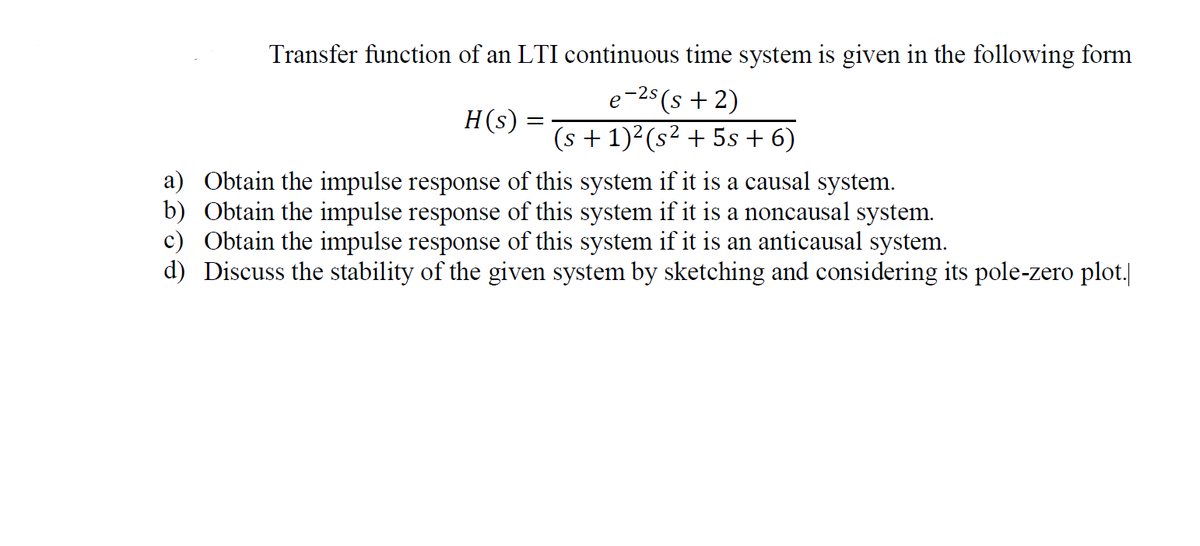Transfer function of an LTI continuous time system is given in the following form e-2s(s + 2) H(s) (s + 1)²(s² + 5s + 6) a) Obtain the impulse response of this system if it is a causal system. b) Obtain the impulse response of this system if it is a noncausal system. c) Obtain the impulse response of this system if it is an anticausal system. d) Discuss the stability of the given system by sketching and considering its pole-zero plot.|
Transfer function of an LTI continuous time system is given in the following form e-2s(s + 2) H(s) (s + 1)²(s² + 5s + 6) a) Obtain the impulse response of this system if it is a causal system. b) Obtain the impulse response of this system if it is a noncausal system. c) Obtain the impulse response of this system if it is an anticausal system. d) Discuss the stability of the given system by sketching and considering its pole-zero plot.|
Introductory Circuit Analysis (13th Edition)
13th Edition
ISBN:9780133923605
Author:Robert L. Boylestad
Publisher:Robert L. Boylestad
Chapter1: Introduction
Section: Chapter Questions
Problem 1P: Visit your local library (at school or home) and describe the extent to which it provides literature...
Related questions
Question
please solve this with clear writing

Transcribed Image Text:Transfer function of an LTI continuous time system is given in the following form
e
25(s + 2)
H(s)
(s + 1)2(s² + 5s + 6)
a) Obtain the impulse response of this system if it is a causal system.
b) Obtain the impulse response of this system if it is a noncausal system.
c) Obtain the impulse response of this system if it is an anticausal system.
d) Discuss the stability of the given system by sketching and considering its pole-zero plot.|
Expert Solution
This question has been solved!
Explore an expertly crafted, step-by-step solution for a thorough understanding of key concepts.
Step by step
Solved in 6 steps

Knowledge Booster
Learn more about
Need a deep-dive on the concept behind this application? Look no further. Learn more about this topic, electrical-engineering and related others by exploring similar questions and additional content below.Recommended textbooks for you

Introductory Circuit Analysis (13th Edition)
Electrical Engineering
ISBN:
9780133923605
Author:
Robert L. Boylestad
Publisher:
PEARSON

Delmar's Standard Textbook Of Electricity
Electrical Engineering
ISBN:
9781337900348
Author:
Stephen L. Herman
Publisher:
Cengage Learning

Programmable Logic Controllers
Electrical Engineering
ISBN:
9780073373843
Author:
Frank D. Petruzella
Publisher:
McGraw-Hill Education

Introductory Circuit Analysis (13th Edition)
Electrical Engineering
ISBN:
9780133923605
Author:
Robert L. Boylestad
Publisher:
PEARSON

Delmar's Standard Textbook Of Electricity
Electrical Engineering
ISBN:
9781337900348
Author:
Stephen L. Herman
Publisher:
Cengage Learning

Programmable Logic Controllers
Electrical Engineering
ISBN:
9780073373843
Author:
Frank D. Petruzella
Publisher:
McGraw-Hill Education

Fundamentals of Electric Circuits
Electrical Engineering
ISBN:
9780078028229
Author:
Charles K Alexander, Matthew Sadiku
Publisher:
McGraw-Hill Education

Electric Circuits. (11th Edition)
Electrical Engineering
ISBN:
9780134746968
Author:
James W. Nilsson, Susan Riedel
Publisher:
PEARSON

Engineering Electromagnetics
Electrical Engineering
ISBN:
9780078028151
Author:
Hayt, William H. (william Hart), Jr, BUCK, John A.
Publisher:
Mcgraw-hill Education,